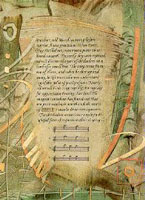History of the Macedonian Music


Macedonian music styles developed under the strong influence of Byzantine church music. It can be stated with some certainty that all of the 3,500 disciples of Clement and Naum studied music as they prepared to spread and establish Christianity, as music education was obligatory for service in the clergy. In addition to spreading the liturgy of the Orthodox Church, they spread Byzantine liturgical music throughout Macedonia. As part of Clement's heritage, 14 Greek manuscripts have been preserved, written in the period between the 11th and the 14th centuries and accompanied by pneumatic notation. "The Bologne Psalter," written in Cyrillic in the village of Raven near Ohrid in about 1235, is accompanied with ecphonetic notation signs. Among the most prominent names in Byzantine church music was John Koukouzeles (14th century), a reformer of the Orthodox chant born in the village of Dzermenci near Debar. He was taken to Constantinople as a young boy to become one of the most distinguished personalities of that time. A founder of new notation characters and new notational signs, he retained only twenty-five of the old ones. Several distinguished successors of Koukouzeles were born in Macedonia as well, such as Joseph, Peter, and Grigorij Koukouzeles. Under Ottoman rule, professional music activity ceased to be practiced and only folk songs remained. Macedonians created their own musical wealth, expressing their sufferings and joys, distresses and beliefs. The folk song remained the only music activity in Macedonia until the 19th century.
In 1894, the first cultural and artistic association was founded in Veles, with the music being its dominant activity. The first modern Macedonian musician was Atanas Badev, born in Prilep in 1860, a student at the Moscow Academy of Music, but his only preserved work is the "Liturgy for a Mixed Choir."
 
At the end of the 19th century, the first choirs and orchestras using notation signs began to appear in Macedonia. These gradually replaced the Turkish calgii, small bands using folk instruments, who played without notation and had introduced oriental elements to the Macedonian music. The Mokranjac choir founded in Skopje in 1922 played a remarkable role in the development of music life in Macedonia. In 1934, the Mokranjac School of Music was opened in Skopje and an active part in its work was taken by Trajko Prokopiev and Todor Skalovski, both of whom later became distinguished Macedonian composers and founders of contemporary Macedonian music, together with Stefan Gajdov, Zivko Firfov, and Petre Bogdanov-Kocko.
On 19th January 1947, the Association of Musicians of Macedonia was founded at the Radio Skopje Building, which laid the foundations of organised music life of the young Macedonian state. Leaders of this association were Petre Bogdanov-Kocko (president), Todor Skalovski, Slavko Kostovski, Vasil Kjortosev, Zivko Firfov, Dragan Gjakonovski-Spato, and Aleksandar Salevski. The main tasks of the association were the preservation of folk music as part of Macedonia's rich folk tradition; the establishment of ethno-musicology institutions which would help collect and record national folk music; upgrading choral performances to modern standards; transforming the schools of music into centres of interest and life for young Macedonians; and to compose works to meet the desires and requirements of the Macedonian people. On 5th February 1947, the first concert of the Radio Skopje Symphonic Orchestra was given, conducted by Todor Skalovski, and featuring soloists Didar Ali on violin, Liljana Kostic on piano, Gligor Smokvarski on clarinet, and Ivan Vlahov on viola. The program included works by Mozart, Chopin, and Dvorak, but more than its content, its context was that of an exceptional event in the music life of the country. The appearance of five collections of choir compositions by Macedonian composers in the course of the following few months in 1947 was perhaps even more significant
  On 19th June 1950, the Composers' Association of Macedonia was founded, replacing the Association of Productive Musicians of Macedonia. In the meantime, the first Macedonian ballet, A Macedonian Story by Gligor Smokvarski, and the first Macedonian opera, Goce by Kiril Makedonski, were performed along with the first extensive symphony works by young Macedonian composers. The most distinguished in that second generation of composers were Blagoja Ivanovski, Vlastimir Nikolovski, Taki Hrisic, Toma Prosev, Tomislav Zografski, Sotir Golabovski, Aleksandar Lekovski, Dragan Suplevski, and Mihailo Nikolovski. Their works represent a rich spectrum of music genres and signalled a great improvement in the quality of Macedonian original music compositions.This trend was continued by the emergence of a group of young, highly-educated Macedonian composers including Risto Avramovski, Stojce Tosevski, Aleksandar Dzambazov, Stojan Stojkov, Ljubomir Brangjolica, Ilija Ilievski, Blagoj Canev, Toma Mancev, Slave Dimitrov, Kiril Todorovski, Jane Kodzobasija, Dimitrie Buzarovski, Goce Kolarovski, and Jana Andreevska, who introduced a new style, genre, and aesthetic versatility to the Macedonian music portfolio. From Macedonia Yesterday and Today by Jovan Pavlovski & Misel Pavlovski (www.mian.com.mk)
Translated by: Zaharija Pavlovska
|